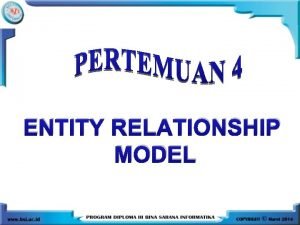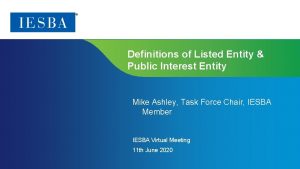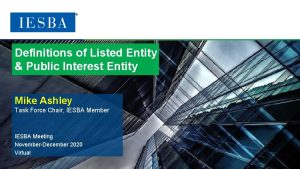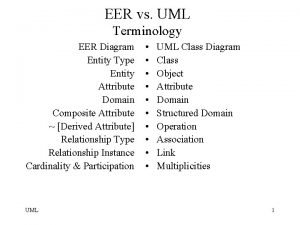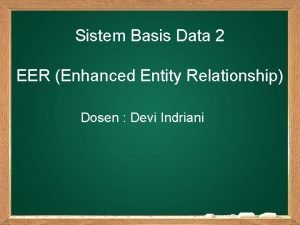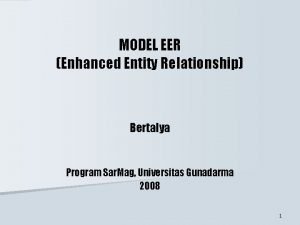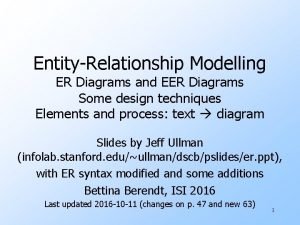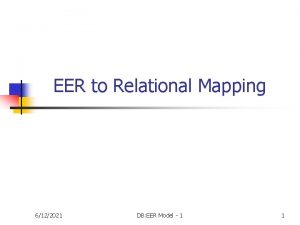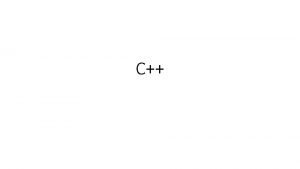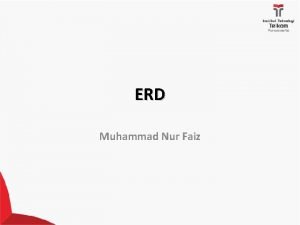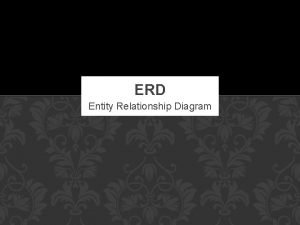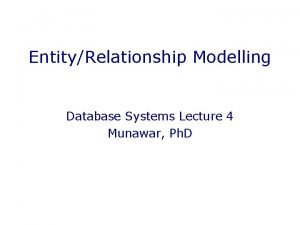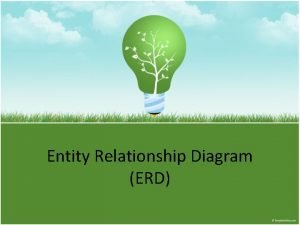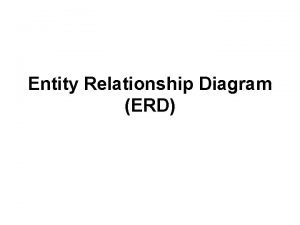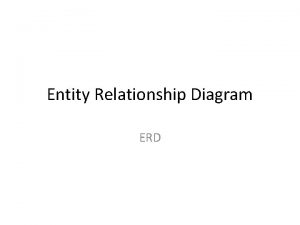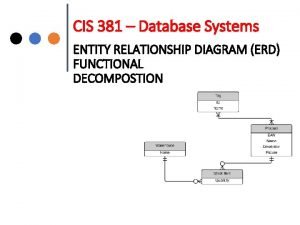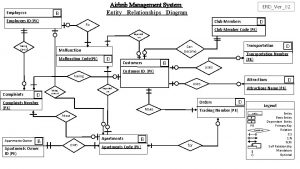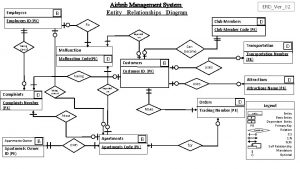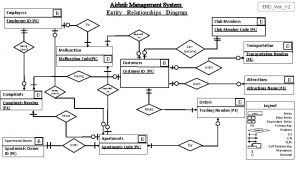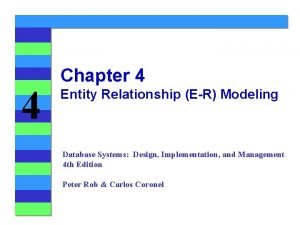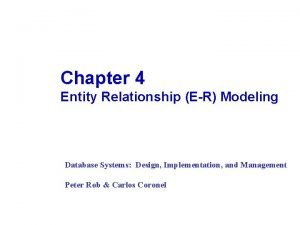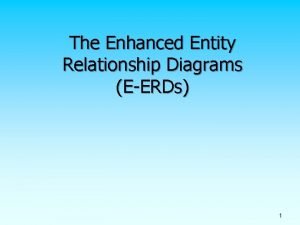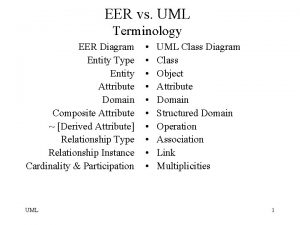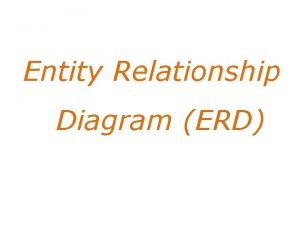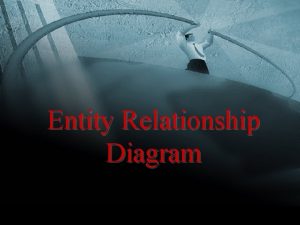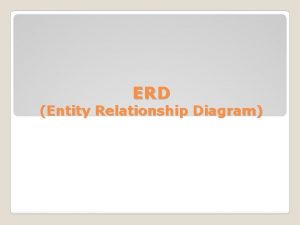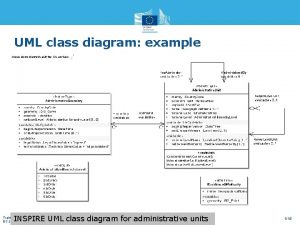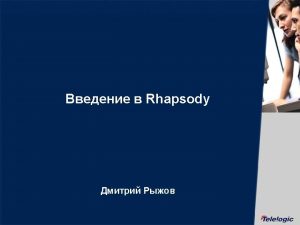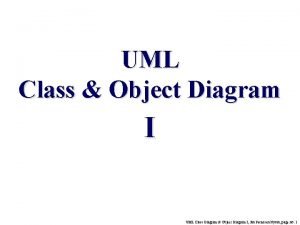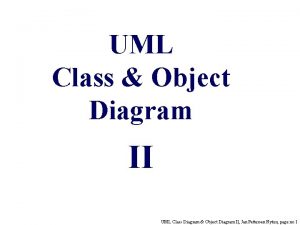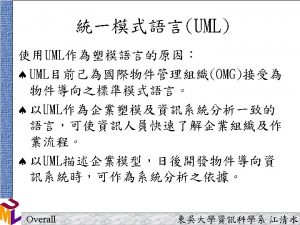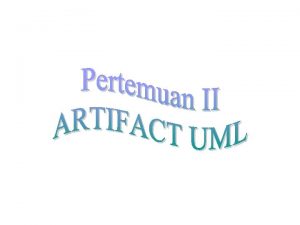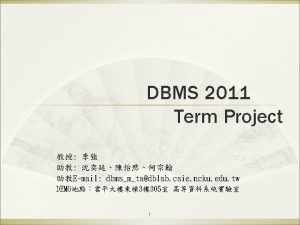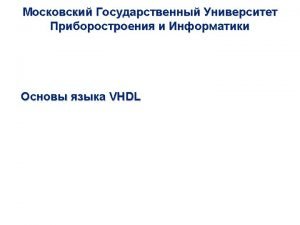EER vs UML Terminology EER Diagram Entity Type


























- Slides: 26

EER vs. UML Terminology EER Diagram Entity Type Entity Attribute Domain Composite Attribute ~ [Derived Attribute] Relationship Type Relationship Instance Cardinality & Participation UML • • • UML Class Diagram Class Object Attribute Domain Structured Domain Operation Association Link Multiplicities 1

EER Example E# N Is In 1 D# Department DNAME Employee N NAME FNAME Assigned To M Project LNAME %TIME UML P# PNAME 2

Diagrams EER vs. UML Class E# Employee NAME FNAME Structured Domain E# NAME: Name. Dom FNAME LNAME Attributes Methods … LNAME Entity Type vs. Class Attribute Composite Attribute vs. Structured Domain UML 3

Department EER vs. UML Complete Diagram D# DNAME … 1. . 1 Min participation (0 or some int n: n>0) D# E# N Employee Department 1 Is In Employee NAME DNAME Max Cardinality N P# Assigned To LNAME %TIME PNAME UML E# NAME: Name. Dom FNAME LNAME … 0. . * M Project FNAME 0. . * Assigned. To %TIME Project P# PNAME … 4

EER Derived Attributes - Include in Department the average salary of the employees in the department. Employee Member Of Salary Class Method Department Avg. Sal Department D# DNAME Avg. Sal UML 5

EER Multi-valued Attributes Student Major EER Multi-valued as Entity Major Student N Has Major 3 Major_Program UML Student … … UML 0. . * Major_Program 0. . 3 Major … 6

Weak Entities EER Weak Entity Employee Name 1 Dependent Name SSN Employee SSN Name … Dependent Name UML Dependents Of N UML Qualified Association Dependent … … 7

Aggregations Location Department Project Name 0. . * No … UML No No No Name 1. . 1 Location Name 1. . * 0. . * Department Name No … … 8

Example: University Database Emp. ID SSN Salary d disjoint o overlap superclass Employee partial subclass U Degree Program o U Name Grad Student U Person total U • Superclasses & Subclasses • Generalization & Specialization • Inheritance Superclass instance must always exist. d U Student Major Dept Undergrad Student Class UML 9

UML Superclass/Subclass Inheritance Employee Emp. ID Salary … Person SSN Name … UML Student Major. Dept … EER UML disjoint d overlapping o Grad. Student Degree. Program … Undergrad. Student Class … 10

Object-Oriented Approach Motivation • Object-Oriented Databases (OODB) – Add persistence to object-oriented programming languages UML • Object Relational Databases (ORDBMS) – Add user-defined methods to relational databases – Allow grouping of relations into more complex “objects” 11

Relational is Good For • Fixed format data • Transaction processing: simple short transactions • Concurrency control • Recovery from crashes • Query processing and Query optimization – relational algebra and mathematical logic operations. UML 12

Problems • The relational model has no notion of a single object. • Context with the real world e. g. , spatial context. • Aggregation functions may be desired • The notion of re-use cannot be exploited • There may also be versions or variant configurations UML i. e variations of the same design. 13

Problems With the Relational Model - 1 • Nonhomogeneous collection of design objects. • Data Types: images, matrices, vectors; variable length. • Temporal and/or spatial data. • Many data types; few instances of each type. UML 14

Problems With the Relational Model - 2 • Schemas evolve during design. • Long running transactions: "checkout a design". • Versions; design log. UML 15

Problems With the Relational Model - 3 • Functions needed: – Making a design permanent, – Releasing design to production, – Archiving design, – etc. • Library of design objects: – minimize redundancy. UML 16

Object-Oriented Concepts - 1 • Complex Objects: – sets, – bags, – lists, – arrays, – tuples. UML 17

Object-Oriented Concepts - 2 • Object Identity: identify by object id (oid) rather than by an attribute value, never changes. • Encapsulation: Operations and Data available to user. • Implementation hidden. No other operations available. UML 18

Object-Oriented Concepts - 3 • Types and/or Classes: – Type: • Interface and Implementation. • Types declared, checked at compile-time – Class: • Instances created at run-time UML 19

Object-Oriented Concepts - 4 • Class or Type Hierarchies: – Inheritance: both data and function example: student: undergraduate, graduate • Overriding, overloading, and late binding: – Polymorphism UML 20

Object-Oriented Concepts - 5 • Computational Completeness: • Extensibility: – Means to define new types. – User types not distinguished from system types. • Persistence: – Not present in OO programming languages. – Should be implicit not explicit. UML 21

Object-Oriented Concepts - 6 • Secondary Storage Management: • Concurrency: • Recovery: • Ad Hoc Query Facility: UML 22

Review: Object • State (value) • Behavior (operations) – Signature or interface: operation name and arguments – Method or body: implementation • Identified by unique Object Identifier (OID) UML 23

Class • Group of similar objects • Class hierarchies – Inheritance • Persistence must be specified explicitly – Via entry point – Via reachability UML 24

Type Hierarchies and Inheritance (EER – superclass/subclass relationship) PERSON: Name, Address, Birthdate, Age, SSN EMPLOYEE: subtype-of PERSON: Salary, Hire. Date, Seniority STUDENT: subtype-of PERSON: Major, GPA EMPLOYEE: Name, Address, Birthdate, Age, SSN, Salary, Hire. Date, Seniority STUDENT: Name, Address, Birthdate, Age, SSN, Major, GPA UML 25

Object Data Management Group (ODMG) • • Object Model Object Definition Language (ODL) Object Query Language (OQL) Bindings to object-oriented programming languages – C++, Java, Smalltalk UML 26
 Simbol lrs
Simbol lrs Simbol weak entity
Simbol weak entity Public interest entity
Public interest entity Public interest entity
Public interest entity Uml 2
Uml 2 Eer
Eer Maksud dari shared-subclass pada model erd adalah
Maksud dari shared-subclass pada model erd adalah Enhanced erd
Enhanced erd Contoh diagram eer
Contoh diagram eer Eer diagram
Eer diagram Eer diagram
Eer diagram Uml data types
Uml data types Contoh er diagram
Contoh er diagram Tujuan erd
Tujuan erd Student course entity relationship diagram
Student course entity relationship diagram Elements of entity relationship diagram
Elements of entity relationship diagram Simbol entity relationship diagram
Simbol entity relationship diagram Fully attributed erd
Fully attributed erd Chen erd
Chen erd Definisi erd
Definisi erd Airbnb entity relationship diagram
Airbnb entity relationship diagram Airbnb erd
Airbnb erd Airbnb er diagram
Airbnb er diagram Pengertian entity relationship diagram
Pengertian entity relationship diagram What is multivalued attribute in er diagram
What is multivalued attribute in er diagram Airbnb erd
Airbnb erd Erd supertype subtype
Erd supertype subtype

